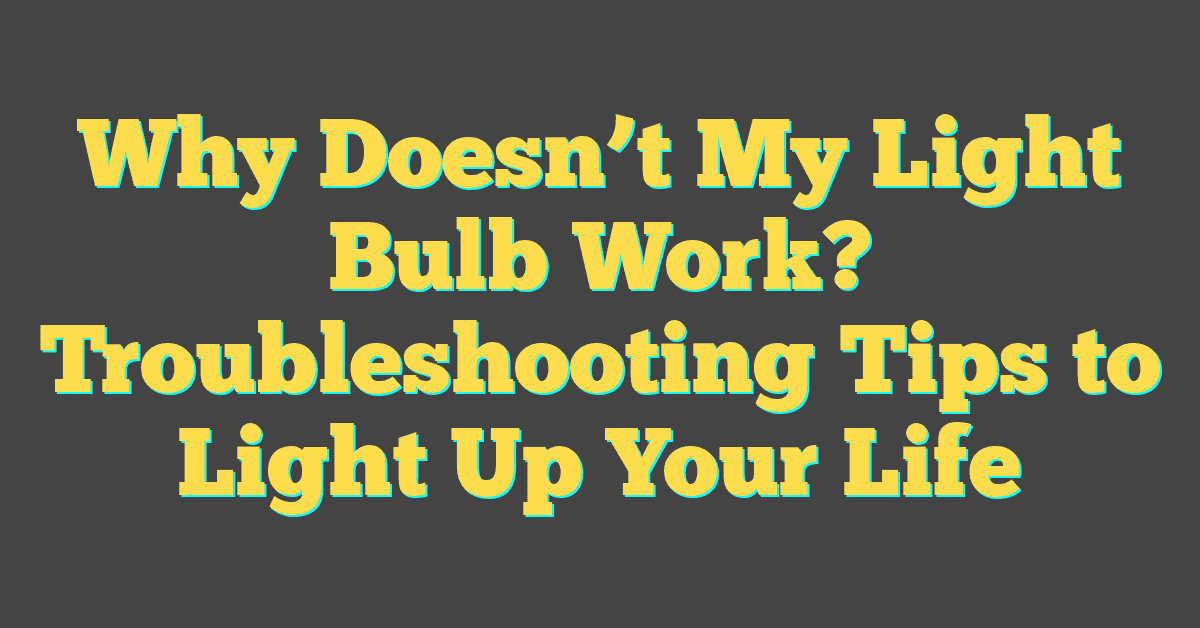Imagine life without that little twist of glass and metal perched above you. It’s hard to picture, isn’t it? Light bulbs have become such an integral part of your daily routine that it’s easy to overlook the immense convenience they bring to your life.

From the moment you flick on the switch in the morning to the soft glow that lulls you to sleep at night, light bulbs are there, silently banishing the darkness and making everything just a bit easier. They’ve transformed the way you live, work, and play, turning night into day at your whim.
In a world that never sleeps, the humble light bulb stands as a beacon of progress, a simple invention that’s sparked a revolution in how you experience and interact with your surroundings. Let’s shed some light on this brilliant piece of technology that’s so seamlessly woven into the fabric of your everyday life.
Evolution of the Light Bulb
Picture this: you’re sitting at home, about to start a DIY project, but without adequate light, you might as well be trying to hammer nails with a banana. That’s where the humble light bulb comes into the equation—a true beacon of progress no toolbelt could be without.
From the very first flicker of Thomas Edison’s incandescent bulb in 1879, light bulbs have undergone a remarkable transformation. In their infancy, these bulbs were a luxury few could afford and they burned out quickly. Over time, advances in technology allowed them to shine brighter, last longer, and become a staple in homes worldwide.
Fast forward to the 20th century and enter the era of fluorescent lighting. Suddenly, you could light up your workspace with a cooler, more energy-efficient bulb. These tubular beacons were all the rage, especially in commercial spaces where their long life and lower heat emissions were highly prized.
As your lighting expert, it’s thrilling to talk about the latest chapters in the story of the light bulb: LEDs. Let’s lay down some facts:
| Attribute | Incandescent | Fluorescent | LED |
|---|---|---|---|
| Lifespan | Short | Moderate | Very Long |
| Energy Use | High | Medium | Low |
| Heat Emission | High | Low | Very Low |
LEDs are where it’s at for your home projects. They use a fraction of the electricity, last for years, and barely raise a degree in temperature—which is brilliant if you’re working up close and personal with your lighting.
Ironically, as much as we’ve moved on from those early, fragile bulbs, the wisdom behind them remains unchanged. Your lighting setup—whether for a soft ambiance in your living room or for precision tasks in your garage—reflects a history of continual improvement and optimization. The light bulb has not only brightened spaces but has sparked innovation, weaving itself into the fabric of our modern lives.
So the next time you flip that switch, remember you’re not just illuminating a room. You’re partaking in a legacy of human ingenuity that’s still on the rise—shining a light on what’s possible, quite literally, at the flick of a switch.
The Impact of Artificial Lighting

Artificial lighting has profoundly transformed the way you live, work, and play. From extending the day to foiling the night’s limitations, light bulbs empower you to be productive, safe, and comfortable no matter the time. Consider your daily routine; from the moment you wake and switch on the light, artificial lighting supports your every activity.
Convenience at Your Fingertips
Just think about home DIY projects – a sphere where lighting is not just convenient, but essential. Intricate tasks like painting, detailing, or crafting demand ample light to ensure precision and safety. LEDs, with their bright and adjustable illumination, offer the perfect solution. Here’s how light bulbs elevate your DIY game:
- Spotlighting: LED bulbs focus light onto specific areas, enhancing visibility during detail-oriented tasks.
- Color Rendering: With excellent color rendering, LEDs allow you to see the true color of the paint or fabric, making your project outcome more predictable.
- Energy Efficiency: LEDs conserve energy, reducing the impact on your bill even when you’re burning the midnight oil on a project.
The Social Dimension
In the realm of social interaction, artificial lighting creates ambiances that foster connection and celebration. Imagine hosting a dinner without the soft glow of a lamp or guiding lights that add warmth and charm to a space. Your choice of bulbs can alter the feel of a room, playing a key role in setting the right mood for social events or a peaceful night in.
Light and Well-Being
Moreover, the right kind of light bulb influences your well-being. Natural-light imitating LEDs can help regulate circadian rhythms, enhancing sleep quality. For night owls or those with irregular schedules, this adaptability in lighting is a lifeline to maintaining a semblance of normalcy.
Revolutionizing Public Spaces
« What Light Bulbs Are Eco Friendly: Upgrade to Greener Light
Difference Between A15 A19 Light Bulb: Choose the Right One »
On a larger scale, bright and efficient lighting revitalizes public spaces, making streets safer and cities more vibrant after dark. With innovations in LED technology, urban spaces are not only well-lit but are also turning more sustainable, casting a new light on the future of city planning.
Altogether, artificial lighting isn’t just a tool; it’s a facilitator of modern life. Its omnipresence goes unnoticed often, yet it’s foundational to how you navigate spaces and carry out tasks, whether you’re tinkering on a home project or enjoying the nightlife in a bustling city.
Energy Efficiency and Cost Savings

Efficiency in your home begins where you’d least expect it— the humble light bulb. Advances in technology mean that LED bulbs are leaps and bounds ahead of older incandescent and fluorescent bulbs in terms of energy efficiency. They use up to 90% less power to produce the same amount of light. What does this mean for your wallet? It translates to significant cost savings over the lifespan of each bulb.
LED Lifespan and Long-Term Savings
While the upfront cost of an LED bulb might be higher compared to traditional options, don’t let that deter you. Let’s break down the numbers:
| Type of Bulb | Average Lifespan |
|---|---|
| Incandescent | 1,200 hours |
| Fluorescent | 8,000 hours |
| LED | 25,000+ hours |
With LEDs lasting more than 25 times longer than incandescent bulbs, you’ll be replacing bulbs less frequently. This not only reduces the hassle for you—it also means spending less time climbing ladders and more time enjoying your well-lit, cozy home environment.
Decrease Your Carbon Footprint
Besides the savings on your energy bill, there’s an added bonus—lowering your carbon footprint. By using LEDs, you significantly reduce your home’s energy consumption. This is more than savings; it’s about participating in a global effort to reduce electricity usage and mitigate climate change. Imagine if every household took this step. The collective impact would be astounding.
DIY Projects and LED Versatility
As a DIY enthusiast, the efficiency of LEDs offers yet another edge—they come in various shapes, sizes, and colors to fit almost any project. Whether you’re designing a custom lighting fixture or adding accent lighting to your shelves, LEDs provide the flexibility without the extra energy costs. Their efficiency empowers your creativity, letting you experiment with lighting solutions without the worry of a steep electric bill.
It’s becoming increasingly clear that the shift towards energy-efficient lighting is not just a trend; it’s a smart lifestyle choice. Whether it’s the longevity, savings, or environmental benefits, LEDs are reshaping our concept of lighting one bulb at a time. So next time you’re at the store pondering the lighting aisle, remember that what you choose impacts more than just your immediate space—it’s a long-term investment in your home and our planet.
Lighting Design and Aesthetics

When you’re undertaking a DIY lighting project, you’re not just looking to brighten a room; you’re sculpting with light. Lighting design plays a pivotal role in bringing your home’s features to life, creating moods, and enhancing overall aesthetics. With LED bulbs at your disposal, the palette of your design becomes vast and incredibly diverse.
Color Temperature is a key element in lighting aesthetics. Imagine your cozy bedroom bathed in a warm, soft glow that invites relaxation, or your home office lit with a crisp, bright light that increases your focus. LEDs offer you a spectrum of color temperatures to choose from, measured in Kelvin (K). Warmer lights are typically within the 2700K to 3000K range, while cooler, daylight-like colors fall around 5000K to 6500K.
Beyond temperature, LEDs can also be Dimmable. Being able to adjust the brightness means you can set the intensity to suit the time of day, the activity, or just your mood. And they achieve this with such finesse that there’s no flickering or humming, just seamless transition from bright to cozy.
The direction and spread of light play into the mix as well. Strategically placed LEDs can accentuate artwork, highlight architectural details, or create an illusion of space. They do this without overshadowing the room’s character but rather enhancing the texture and tone where it counts.
For those of you who relish in the latest tech, Smart Lighting systems have taken lighting design to a new level of convenience and control. With your smartphone or voice commands, you can adjust settings, create scenes, or even program your lights to respond to your daily routines.
And let’s not forget about the ability of LED lights to blend into your décor. Your DIY projects can take advantage of the Versatile Designs of LEDs that range from vintage Edison-style bulbs to ultra-modern fixtures. This adaptability means they can become an integral part of your home’s aesthetic rather than just a functional element.
Through Lighting Design and Aesthetics, the power is in your hands to turn your home into a testament of your taste and style, one bulb at a time. Keep all these considerations in mind and let the light guide your next home project to new heights.
Advancements in Light Bulb Technology

As you dive deeper into the world of lighting for your DIY projects, you’ll marvel at the leaps in light bulb technology. LEDs, once a novel innovation, are now at the forefront, blending energy efficiency with exceptional longevity. But it’s not just about using less power or fewer bulb replacements. There’s a spectrum of advancements that are tailor-made for home enthusiasts like you.
Smart bulbs have revolutionized the way you interact with your home. Imagine adjusting the brightness, color, and even the on-off schedules all from your smartphone or voice-controlled device. With smart technology, you’re not just turning on a light; you’re setting the scene, creating ambiance, or enhancing security while you’re away.
The material science behind bulbs has seen significant upgrades too. Manufacturers are using durable compounds that not only increase the lifespan but also ensure consistent light output over time. This means your creative lighting setups maintain their brilliance year after year, which is especially important in areas where lighting is not just functional but a key part of the decor.
In the realm of color and brightness, color rendering index (CRI) has become a critical measurement for light quality. High CRI bulbs ensure that the colors in your space look natural and vivid, just how they do in daylight. This is a game-changer for areas where you do detailed work or where accurate color perception is paramount.
Another aspect shaping the future of home lighting is connectivity. Light bulbs can now be part of your holistic smart home system. Imagine your bulbs communicating with other devices, providing optimal lighting based on the time of day, weather, or even syncing with your home entertainment system for an immersive experience.
Encompassing these advancements, it’s clear that light bulbs aren’t just sources of light anymore. They are dynamic tools waiting to transform your home project ideas into a well-lit reality. With all these choices at your fingertips, crafting the perfect atmosphere in every room has never been easier or more exciting.
Conclusion
So you’ve seen just how transformative light bulbs can be in your daily life. They’re not just about visibility anymore; they’re about shaping the space around you to fit your lifestyle and mood. With smart tech at your fingertips, you’re in control, creating an ambiance that’s as unique as you are. It’s clear that the humble light bulb has evolved into a crucial component of modern living, illuminating your world in ways you might never have imagined. Now, it’s up to you to light up your home projects with the brilliance of LED innovation. Embrace the glow and watch your spaces come alive.
Frequently Asked Questions
What are the benefits of using LED bulbs in home lighting projects?
LED bulbs offer energy efficiency, a long lifespan, and the ability to customize with various color temperatures and dimming options. They can enhance the aesthetic appeal of home decor and be integrated into smart lighting systems.
How do LED bulbs enhance home decor?
LED bulbs come in versatile designs that can complement any home decor. Their ability to adjust color temperature and brightness allows them to create the desired ambiance for different rooms and occasions.
Can LED bulbs be controlled through smartphones?
Yes, with advancements in light bulb technology, smart LED bulbs can be controlled using smartphones or voice-controlled devices, offering convenience and flexibility in home lighting.
Why is the Color Rendering Index (CRI) important for LED bulbs?
The Color Rendering Index (CRI) measures the ability of a light source to reveal the colors of various objects faithfully in comparison to a natural light source. A high CRI LED bulb ensures more natural and vivid colors in your home.
How do LED bulbs fit into a smart home system?
LED bulbs can connect with other smart devices in your home through a central smart home system, allowing for automated lighting settings, energy savings, and improved home security through scheduling and remote control capabilities.




